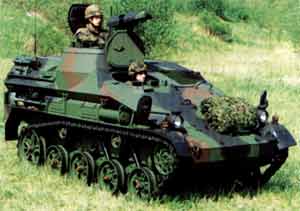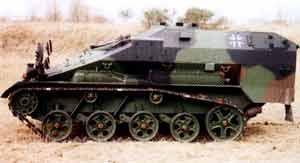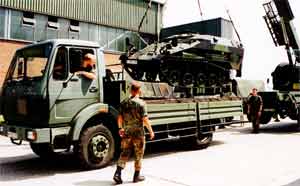| Designation: | Wiesel 2 |
 |
|---|---|---|
| Manufacturer: | MAK SYSTEM GESELLSHAFT MBH | |
| Product type: | Armoured Vehicles | |
| Name: | Reconnaissance Vehicle |
Development
The prototype of the Wiesel 2 light armoured air-transportable vehicle, developed by the now Rheinmetall Landsysteme as a private venture with the assistance of a number of subcontractors, was completed at Kiel in mid-1994.
Between 1989 and 1992, the now Rheinmetall Landsysteme built a total of 345 Wiesel 1 (covered in detail in a separate entry) Armoured Weapon Carriers (AWCs) for the German Army.
Market studies by the company showed that there was a requirement for a new version of the Wiesel with an increased volume and payload to enable it to carry out a wide range of additional missions on the battlefield, including the support of the existing Wiesel 1 vehicles which are purely weapon carriers.
The result is the Wiesel 2, which has a stretched hull with an additional roadwheel either side and a slightly higher roof line.
The chassis of the Wiesel 2 was first selected as the basis for the German Army's new LeFlaSys Stinger self-propelled air defence system (covered under Variants) as this is the first production application of the Wiesel 2 system. Production of the Wiesel series was originally undertaken in Kiel but has now been transferred to Unterluess.
Late in 2006 Rheinmetall was awarded a contract by the Bundesamt für Wehrtechnik Beschaffung (BWB) for an additional batch of 13 Weisel 2 light tracked armoured vehicles configured in the ambulance role.
Production of these will be undertaken at Unterluess with deliveries completed by the end of 2007. The company has also been awarded a second contract for two Wiesel 2 driver training vehicles and two training models plus logistic support. Total value of these two contracts is about EUR9 million.
These two contracts brought the total Wiesel 2 production order book for the German Army to over 140 units. This includes a total of 69 for the low air-defence system (all delivered), ambulance (20 being delivered), engineer reconnaissance vehicles (nine delivered) and mobile command post (26 delivered with another six being built).
A number of other variants are currently being tested by the German Army including two prototypes of a 120 mm self-propelled mortar system. Orders are expected to be placed for these in the future as well as other specialised versions such as forward air control, forward observation vehicle and the 120 mm mortar forming part of the Joint Fires Support Team.
It is expected that in the longer term and funding permitting, the German Army will have a fleet of over 300 Wiesel 2 vehicles with most variants capable of being carried inside a CH-53G tactical transport helicopter. Description
The layout of the Wiesel 2 is similar to the Wiesel 1, with the engine compartment front left, driver front right and the remainder of the vehicle for the troop compartment.
The troops enter the vehicle through a large door in the hull rear that opens to the left. The commander's position is to the rear of the driver.
The Wiesel 2 has twice the internal volume of the earlier Wiesel 1, with the prototype being configured as a half squad carrier.
This version can carry six people including the driver and commander, with the commander manning the Krauss-Maffei Wegmann 7.62 mm MG3 machine gun mount which enables the weapon to be fired from under complete armour protection.
Using the Wiesel 2 as a basis, the company has proposed a wide range of versions including command post, medical evacuation vehicle, radar carrier, reconnaissance vehicle, NBC vehicle and as a weapons platform.
A full-scale mock-up of the ARGUS 2 reconnaissance vehicle has already been completed which features a three-man crew, a retractable mast-mounted sensor package and touch menu displays to allow for extended operations.
A CH-53 helicopter, as used by the German Army, can carry two Wiesel 2 vehicles internally and the Wiesel 2 can also be slung underneath helicopters such as the CH-53 and CH-47.
The new Wiesel 2 shares a number of common components with the earlier Wiesel 1 but has a new Diehl Type 622 track and a new power pack.
The new power pack consists of the new low-emission Audi 1.9 litre four-cylinder turbocharged diesel developing 109 hp coupled to a ZF LSG 300/4 automatic transmission. The Audi 4-cylinder TDI engine has an electronic control system that automatically tunes the engine and transmission output depending on the vehicle weight. Variants
Development of this is complete and details are given in a separate entry.
Four German companies were originally awarded fixed-price study contracts for the LeFlaSys (Leichte Flugabwehrsystem) and in 1995 Rheinmetall Defence Electronics was awarded the contract, which included the design, development and manufacture of preproduction systems plus the full production order.
By early 1997, the now Rheinmetall Defence Electronics had completed one weapon platform Ozelot, one platoon command post and one reconnaissance vehicle 'low level'. The first two are based on the latest Rheinmetall Landsysteme stretched Wiesel 2 light tracked armoured vehicle chassis while the reconnaissance vehicle is based on the Mercedes-Benz Wolf (4 × 4) vehicle.
The weapon platform Ozelot has an unmanned mount at the rear, with four European-built Raytheon Systems Company Stinger fire-and-forget Surface-to-Air Missiles (SAMs) in the ready-to-launch position.
When travelling, the missile launcher system is retracted to allow the complete weapon platform to be driven into the CH-53H transport helicopters of the German Army.
Although the weapon platform Ozelot would normally use the Stinger SAM, one of the requirements of the German Army was that it should also be capable of firing the Russian Kolomna KBM Igla-1 (SA-16 'Gimlet'), as the German Army has large quantities of these available for training purposes.
Each weapon platform Ozelot is also fitted with communications equipment and a Thales Land & Joint Systems passive Air Defence Alert Device (ADAD) which has been in service with the British Army for some years in both static (for example tripod-mounted) and vehicle-mounted (Starstreak High-Velocity Missile) roles.
The Ozelot platoon command post is fitted with an improved version of the Swedish Ericsson Microwave Systems HARD (Helicopter & Airplane Radio/Radar Detection) 3-D radar system.
A third LeFlaSys vehicle, also on a Wiesel 2 chassis, is the battery command post. It is expected that the single LeFlaSys regiment will have three batteries with each of these comprising battery HQ unit and three platoons.
The reconnaissance vehicle 'low level', based on a Mercedes-Benz (4 × 4) Wolf, is foreseen as an interface for allied forces, receiving and transmitting reconnaissance data via the so-called FAST interface.
Each platoon will have one platoon command post with the HARD radar and control five Ozelot weapon platforms.
The total order, including the prototype systems, consists of 50 weapon platforms, 10 platoon command posts (with radar) and seven battery command post vehicles, all on the Wiesel 2 multipurpose carrier chassis.
The first production Wiesel 2 multipurpose carrier chassis was completed in 1999 and then sent to Krauss-Maffei Wegmann for internal work, before being sent to Rheinmetall Defence Electronics for final integration and delivery to the customer.
Full details are given in Jane's Land-Based Air Defence. The first platoon of the German Army equipped with this system became operational in the first quarter of 2001. Deliveries of the ASRAD system to the German Army have now been completed.
In 1997, the now Rheinmetall Landsysteme completed the prototype of the Wiesel 2 ambulance and this was subsequently tested by the German Army who in 2001 placed a contract for 20 systems for delivery between 2002 and 2003. An additional 13 were ordered late in 2006.
Within the German Army the Wiesel 2 ambulance is referred to as the Wiesel 2 SanTrp with the ambulance equipment being supplied by the German company Binz.
This model has a crew of two, consisting of the driver and the leader of the medical party and can carry one stretcher case and two seated patients. The patients can rapidly enter the vehicle via the two large doors in the rear of the hull.
In addition to its specialised medical equipment, standard equipment includes a hot water heater, NBC system and a cooling system for the crew compartment.
The German Army has tested a preproduction example of the Wiesel 2 Engineer Reconnaissance Vehicle (ERV) which has been developed by the company specifically to meet the operational requirements of the German Army airborne brigades. Special kits for different missions have been developed. These include blockades, demolition and water reconnaissance.
The Wiesel 2 ERV will be used to support German airborne engineer troops and standard equipment includes a roof-mounted 7.62 mm MG3 machine gun, NBC system and a command and control system.
It carries a full range of specialised tools and equipment to enable the engineers to carry out a number of battlefield missions such as water reconnaissance, demolition and blockade. Four production vehicles were ordered and these were delivered from mid-2005.
This has also been developed to meet the requirements of the German Army and has a payload of up to 1,000 kg and would typically be used to support the Wiesel 1 armoured weapon carriers. It is expected that nine ammunition transport vehicles will be ordered.
It is expected that the German Army will order a total of 90 120 mm SP mortar systems, plus 116 command and support vehicles.
116 command and support order would comprise 22 forward observer vehicles, 26 command and fire-control vehicles, 23 command post vehicles and 45 ammunition transport vehicles.
In mid-2004 the German BWB awarded Rheinmetall Landsysteme (RLS) a contract worth EUR31 million for the supply of 32 Wiesel 2 in the Mobile Command Post (MCP) configuration, with an option on an additional 16 vehicles.
Production of these MCPs will be undertaken at the RLS facility at Unterluess. The first 11 were delivered in 2005, 15 in 2006 and the remaining six in 2007. If the option for the additional 16 is exercised then these will be delivered in 2008.
These Wiesel 2 MCP will be used by the German Army's Division of Special Operations (DSO), which now includes the airmobile forces.
The Wiesel 2 chassis is used as the basis for the Syrano robotic vehicle developed in France as a technology demonstrator.
Two so-called digitalised Wiesel 2 vehicles were delivered to the German MoD early in 1998. One is a robot carrier and the second is used as a control station for use in the PRIMUS (Programme for Intelligent Mobile Unmanned Systems) project.
Rheinmetall Landsysteme has built a full-scale mock-up of the ARGUS 2 Airtransportable Armoured Surveillance and Reconnaissance Vehicle as a private venture.
Typical roles for this vehicle would include reconnaissance, scout missions, battlefield surveillance, artillery observation, command missions and security missions.
To carry out its missions, the vehicle is fitted with a mast-mounted sensor pod developed by Rheinmetall Defence Electronics and a command and control system developed by Rheinmetall Landsysteme.
ARGUS also features a hybrid navigation system, intercommunication radio system, NBC system and electric power supply, which includes an additional generator.
This light air-transportable armoured experimental vehicle has been developed by Rheinmetall Landsysteme and features all-electric drive and power supply.
Rheinmetall Landsysteme are now carrying out company trials of a Wiesel 2 light armoured vehicle which has been fully digitised and fitted with a range of specialised sensors.
The main aim of this digitised Wiesel 2 is to provide an understanding of how new and emerging technology can be used for Network Centric Warfare (NCW).
For this role not only has the Wiesel 2 been digitised and fitted with a vetronics architecture but also advanced man/machine interfaces, data technology and a complete suite of sensors.
The system has a crew of three (driver, observer and commander) and can, if required, be operated in a hazardous area by remote control. It can be used for a variety of roles such as command and control as well as reconnaissance.
It is equipped with a navigation and global positioning system as well as air conditioning and has a total of two control handles, five joysticks and six displays.
To carry out its reconnaissance mission it is fitted with the Rheinmetall Defence Electronics BAA mast-mounted day/night sensor pack that is already in service with the German Army on its Fennek (4 × 4) light reconnaissance vehicles.
It also carries a telemax remote-controlled vehicle in a pod at the rear. When deployed this has a maximum speed of 3.5 km/h on tracks or 4.7 km/h on its wheels and is provided with five cameras and has a seven-axis manipulator and a tool changing system. Maximum range is being quoted as 1 km and it has an operating time of about 2 hours.
It also carries a small airrobot unmanned aerial vehicle which weighs only 1 kg and has a range of 500 m and is fitted with a video camera which transmits video in real time to the platform.
Following company trials, it is expected this system will take part in SPRINT (Systronics Project on Intelligent Network Technologies) national trials at the German Army Infantry School at Hammelburg in 2008.
SPRINT will be followed by ARTIST (Advanced Real Time System Testbed) French/German trial at Hammelburg in 2009. This will cover the preparation and execution of four operational scenarios including co-ordinated fire management, unmanned vehicles teleoperation, dismounted infantry operation and distributed simulation.
|
||||||||||||||||||||||||||||||
|
|||||||||
|
||||||||||||
 |
 |
 |

